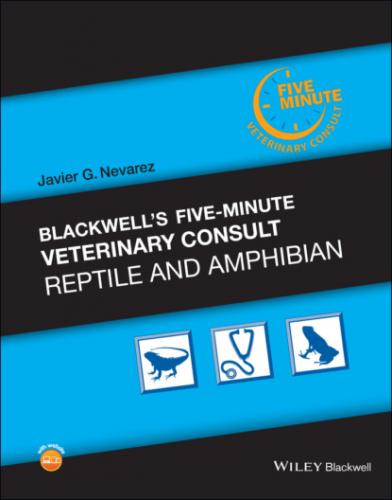If dietary causes are responsible for the diarrhea, then prognosis is good to excellent.
Animals in good body condition with no concurrent morbidities have a good to excellent prognosis.
Animals in poor body condition with signs of systemic illness (dehydration, lethargy, etc.) have a guarded to poor prognosis.
COMMENTS
Diarrhea is a clinical sign associated with an underlying diseases, improper husbandry, or nutrition.
Identification of the underlying cause is necessary to improve outcome and reduce the risk of reoccurrence.
Correction of husbandry is always recommended to in help improve the outcome.
ZOONOTIC POTENTIAL
Salmonella spp. are commonly shed from chelonians with and without diarrhea.
SYNONYMS
N/A
ABBREVIATIONS
CT = computed tomography
PO = per os
Suggested Reading
1 Funk RS. Diarrhea. In: Mader DR, ed. Reptile Medicine and Surgery. 2nd ed. St. Louis, MO: Elsevier Saunders; 2006:772–773.
2 Greiner EC, Mader DR. Parasitology. In: Mader DR, ed. Reptile Medicine and Surgery. 2nd ed. St. Louis, MO: Elsevier Saunders; 2006:343–364.
Author Christoph Mans, Dr. med. vet., DACZM
Dystocia
DEFINITION/OVERVIEW
Dystocia is difficulty laying eggs.
ETIOLOGY/PATHOPHYSIOLOGY
The reproductive hormone mechanism in reptiles is not as well understood as that of mammals.
It is suspected that a multitude of environmental and behavioral factors, as well as underlying diseases, contribute to an abnormal function of the endocrine system, which in turn leads to dystocia.
It is also possible that a lack of breeding and exposure to males may be contributing factors.
In addition to basic husbandry aspects, such as UVB light, temperature, humidity, and a proper diet, female reptiles also have a need for appropriate substrate and environment that is conductive for egg laying.
SIGNALMENT/HISTORY
Dystocia occurs in female chelonians of reproductive age or size.
Most animals have a history of inadequate nutrition and husbandry lacking an appropriate area for laying eggs.
CLINICAL PRESENTATION
Signs of dystocia may include straining with or without vocalization, decreased fecal production, cloacal prolapse, hind limb weakness/paresis, lethargy, and anorexia.
Some animals may also appear restless and may be observed attempting to dig.
In some instances, the eggs may be palpable through the prefemoral fossa during physical exam.
Physical exam should be done carefully to avoid rupturing the eggs.
In most cases, the owners are not aware of the fact that their chelonian is in dystocia.
Other abnormalities identified in physical exam may include dehydration, poor body condition score, and pliable bones.
RISK FACTORS
Husbandry
Inappropriate husbandry is likely a significant contributing factor to the occurrence of dystocia.
Beyond temperature and humidity, inadequate UVB light exposure and calcium supplementation is key in the development of NSHP, which in turn can have a significant impact in calcium availability, egg calcification, and contractions of the reproductive tract.
Chelonians presenting for dystocia may also have concurrent NSHP.
An often‐forgotten aspect of the husbandry of reproductive female chelonians is the provision of an adequate substrate for nesting.
Reptiles that may not perceive the environmental conditions are adequate for successful oviposition may not have the proper stimuli to lay their eggs.
Others
A less‐discussed topic is the effect that lack of exposure to males may have on the reproductive cycle of reptiles.
Many reptiles display courtship and breeding behaviors that likely influence the proper hormonal stimulation of prospective females.
Many female chelonians in captivity are kept alone without the benefit of behavioral cues from a male counterpart.
This possibility of a behavioral effect must be considered, especially when animals are maintained in proper husbandry and are otherwise healthy.
DIFFERENTIAL DIAGNOSIS
Follicular stasis
Neoplasia
Egg yolk coelomitis
Ovarian cysts
GI obstruction
DIAGNOSTICS
Radiography
The eggs of most species appear calcified, round to ovoid, but sea turtle eggs are minimally calcified.
Ultrasound
Appearance of calcified eggs is a well-delineated hyperechogenic eggshell membrane to significant acoustic shadowing.
In those with poorly calcified eggshell, ultrasound may be more sensitive than radiographs at diagnosing broken eggs, which may be associated with egg yolk coelomitis.
CT and MRI
Both these modalities are extremely sensitive at identifying eggs and can better assess their structure, integrity, and location.
Coelioscopy
Coelioscopic examination allows for confirmation of the presence of eggs and ruling out egg yolk coelomitis.
